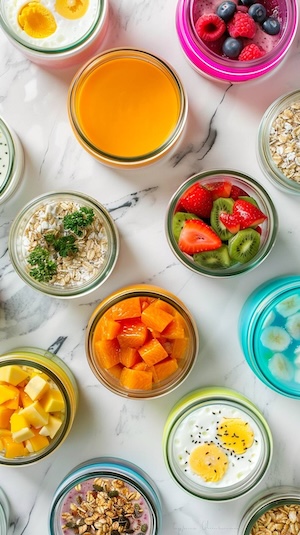PCOS for Picky Eaters: 30 Simple Meal Ideas
Discover 30 simple pcos meals for picky eaters that help manage symptoms. Easy pcos meals picky eaters will love, with practical tips and hormone-balancing ingredients.
Recipe by Lukas Volger Kimchi can be made and eaten any time of the year, but I really crave it in the spring. In this recipe, the kimchi and assorted quick-pickled vegetables are the dominant flavors, making a bright-tasting, tangy bowl. Pickling chard
This recipe includes superfoods such as:
Sesame Seeds, Brown Rice, Kimchi
Transform your health with tailored 7-day meal plans designed specifically for PCOS management. Just $7/month or $59/year.
Get it now →2 bunches Swiss chard (1 to 1 1/2 pounds)
1 big Kirby cucumber or half of a conventional cucumber
1 medium carrot, peeled
6 small radishes
1 tablespoon sugar
3/4 teaspoon plus 1 pinch of fine sea salt
2 teaspoons rice vinegar
1 –2 tablespoons neutral-tasting oil
1 –2 teaspoons toasted sesame oil
1 tablespoon toasted or black sesame seeds
5 cups cooked white or brown rice, or mixed grains, freshly cooked if skipping the rice crisping step
2 (2-inch) squares toasted nori
2 cups chopped Napa Cabbage or Bok Choy
Kimchi, preferably homemade
1 avocado, peeled and sliced
Gochujang or Sriracha, for serving
Trim the stems from the Swiss chard. Cut or tear the leaves into bite-sized pieces and set aside. Reserve half of stems for another use or discard them. Slice the remaining stems into 2-inch lengths, and then into halves, quarters, or eighths to make uniform matchsticks and transfer them to a medium bowl.
Slice the cucumber into 1/2-inch-thick rounds, then stack them up and slice into matchsticks. Slice the carrot into thin (less than 1/4-inch) rounds. Slice the radishes into thinnest possible rounds. Add the vegetables to the bowl with the chard stems. Toss with the sugar and 3/4 teaspoon of the salt and let stand as you prepare the rest of the meal. Just before serving, rinse and drain the veggies, blot dry with a clean towel, and toss with the rice vinegar.
Meanwhile, place a skillet over medium heat and add 1 tablespoon neutral-tasting oil. Using tongs, add the Swiss chard leaves in increments, adding more as each batch cooks down. Add a big pinch of salt and cook, stirring frequently with the tongs for 3 to 5 minutes, until wilted and the pan appears mostly dry. Remove from the heat and gather up the greens to one side of the pan with a spatula. Holding the chard in place and gently squeezing, tilt the pan over the sink and pour off any excess liquid. (You can do this in a colander if you’re worried about accidently dumping the greens into the sink.) Place the chard in a bowl and stir in 1 teaspoon sesame oil and the sesame seeds. Wipe out the skillet.
To make crispy-base bibimbap rice (optional): Just before serving, heat the remaining 1 tablespoon neutral-tasting oil and 1 teaspoon sesame oil in a wide skillet over medium heat. Press the rice into the skillet, making a thick cake. Let cook without disturbing for 4 to 5 minutes, until a golden brown crust forms on the bottom of the rice.
Wave the nori squares over the flame of a gas burner a few times, until the corners curl and they turn crisp, or roast under a broiler, flipping periodically. Slice into thin strips with a chef’s knife, or crumble with your fingers.
To serve, use a spatula to scoop out the rice and divide it among four bowls, ensuring that everyone gets some of the crispy part. Top with the Swiss chard, kimchi, and avocado, then use a slotted spoon to add the pickled vegetables to the bowls. Garnish with the nori and serve immediately, passing the Gochujang sauce at the table.

You know the drill: Alarm goes off. You hit snooze. Rush around frantically. Skip breakfast AGAIN because there's no time. By 10am, you're hangry, your blood sugar is all over the place, and your PCOS symptoms are already acting up.
Sound familiar?
Finally – a meal prep system designed specifically for women with PCOS who refuse to let chaotic mornings derail their health goals.
In just ONE hour on Sunday, you can transform your entire week:
"I went from skipping breakfast 4 days a week to having delicious, hormone-supporting meals ready every morning. My energy is more stable and my cravings have disappeared!"
– Sarah M.
Stop letting chaotic mornings control your health.
Get your hormone-happy mornings starting this Sunday.
→ Get Your 60-Minute Solution Now
Transform your health with tailored 7-day meal plans designed specifically for PCOS management. Just $7/month or $59/year.
Get it now →Serving Size: 4
| Amount Per ONE Serving | ||
|---|---|---|
| Calories 0 kcal | ||
| Fat 0 g | ||
| Carbohydrate 0 g | ||
| Protein 0 g | ||
💡 Introducing the 10/10 PCOS Solution:
Ten Delicious Crockpot Recipes that take just 10 minutes to prep!
Say goodbye to hours in the kitchen and hello to clean, PCOS-friendly meals made effortlessly.
👉 Click here to grab your 10/10 PCOS Solution today! Try The 10/10 PCOS Solution: Ten Crockpot Recipes That Take Just Ten Minutes to Prep
Managing PCOS can be challenging, but you don't have to do it alone. Join our supportive community to connect with others who understand what you're going through, share tips, and get encouragement. Here's how you can get involved:
Subscribe to our Newsletter: Receive PCOS-friendly recipes, tips, research updates, and more delivered straight to your inbox. Stay informed and empowered with the latest information and support.
Join our Telegram Channel: Stay updated with the latest tips and advice on managing PCOS.
Follow PCOS Meal Planner on Facebook: Engage with our community, participate in discussions, and get support from others.
Break the cycle with the PCOS Meal Planner - your personalized guide to eating better, feeling better, and managing PCOS symptoms. Take control today!

Forget the frustrating cycle of weight loss attempts, endless medications, and living in discomfort. Introducing the PCOS Meal Planner. A meal planning guide that goes beyond temporary fixes to offer a comprehensive strategy, empowering you to ignite a transformation towards lasting health and happiness. Step into a world where you control your PCOS, not the other way around.
Unlock Your PCOS Freedom Now.
Discover 30 simple pcos meals for picky eaters that help manage symptoms. Easy pcos meals picky eaters will love, with practical tips and hormone-balancing ingredients.
Discover 15 delicious overnight oats for PCOS recipes that help balance hormones and manage symptoms. Easy, nutritious breakfast ideas perfect for women with PCOS.
Discover the best cereal for PCOS with our expert rankings. Compare brands, check ingredients, and find PCOS friendly cereal that supports hormonal balance.
Learn how to transition away from fruit when starting a ketogenic diet for PCOS. Discover gradual strategies, fruit alternatives, and practical tips for success.
Discover 5 delicious PCOS banana bread recipes with low-glycemic ingredients. Learn how to make hormone-friendly banana bread that supports blood sugar balance.
Creatine for women with PCOS explained simply. Learn safety, benefits, hormone effects, tips, and how creatine may support PCOS symptoms naturally.
Complete PCOS diet plan with foods to eat, foods to avoid, meal timing, and real results. Learn the science-backed approach to managing PCOS through diet, with 7-day meal plan, grocery list, and step-by-step implementation guide. Based on clinical research and real patient outcomes.
Complete guide to ordering at Wendy's with PCOS. Discover the best protein-focused meals, what to skip, and how to customize orders to keep blood sugar stable. Learn which burgers, salads, and sides work for PCOS, plus complete macros for every menu item and smart swaps to avoid insulin spikes.
Complete guide to ordering at Burger King with PCOS. Discover the best protein-focused meals, what to skip, and how to customize orders to keep blood sugar stable. Learn which burgers, salads, and sides work for PCOS, plus complete macros for every menu item and smart swaps to avoid insulin spikes.